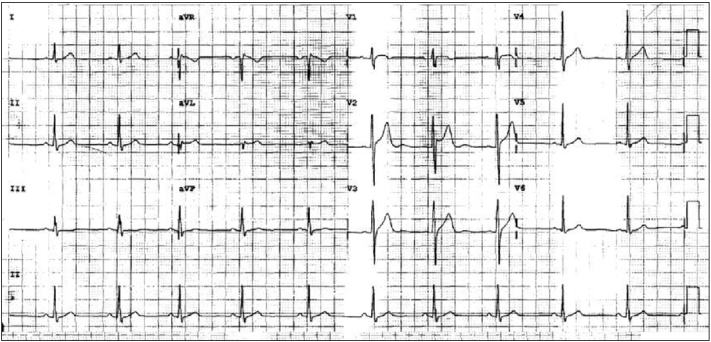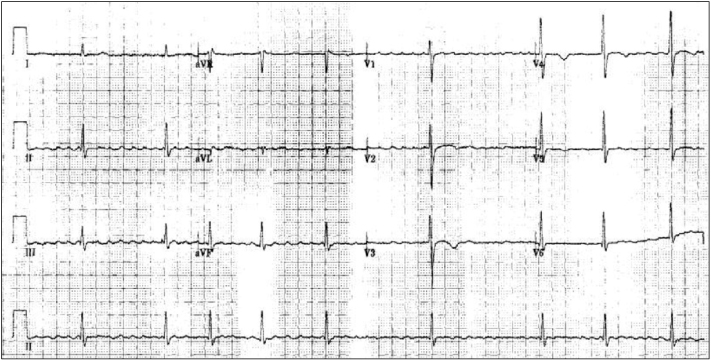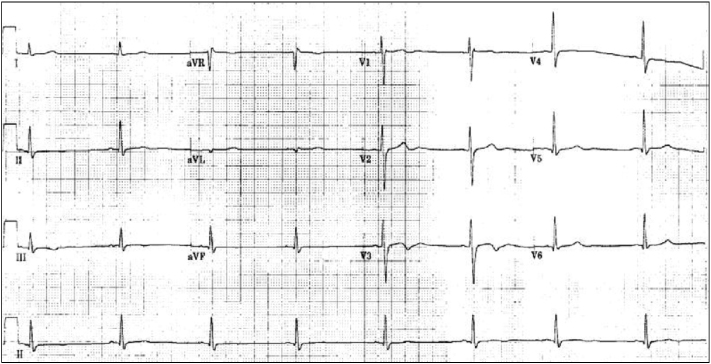Ewha Med J.
2012 Sep;35(2):119-123. 10.12771/emj.2012.35.2.119.
Atrial Fibrillation during General Anesthesia Induction and Paroxysmal Supraventricular Tachycardia on Emergence
- Affiliations
-
- 1Department of Anesthesiology and Pain Medicine, CHA Bundang Medical Center, CHA University, Seongnam, Korea. jongyeonl@yahoo.co.kr
- KMID: 2284003
- DOI: http://doi.org/10.12771/emj.2012.35.2.119
Abstract
- A healthy 35-year-old man who was scheduled for closed reduction of nasal bone fracture developed atrial fibrillation during induction of general anesthesia after intravenous glycopyrrolate injection. During emergence of general anesthesia, atrial fibrillation was suddenly changed to paroxysmal supraventricular tachycardia with 200 beat per minute and lasted for about 10 seconds. Because blood pressure was stable, esmolol was used to reduce ventricular response. At recovery room, ventricular response reduction about 55 beat per minute was observed after intravenous injection of verapamil 5 mg. Thereafter, the rhythm was returned to normal sinus rhythm with bradycardia.
MeSH Terms
Figure
Reference
-
1. Go AS, Hylek EM, Phillips KA, Chang Y, Henault LE, Selby JV, et al. Prevalence of diagnosed atrial fibrillation in adults: national implications for rhythm management and stroke prevention: the AnTicoagulation and Risk Factors in Atrial Fibrillation (ATRIA) Study. JAMA. 2001. 285:2370–2375.2. Crandall MA, Bradley DJ, Packer DL, Asirvatham SJ. Contemporary management of atrial fibrillation: update on anticoagulation and invasive management strategies. Mayo Clin Proc. 2009. 84:643–662.3. Olgin JE, Zipes DP. Braunwald E, Zipes DP, Libby P, editors. Specific arrhythmias: diagnosis and tretment. Branwald's heart disease. 2005. 7th ed. Pennsylvania: Elsevier;803–861.4. Djousse L, Levy D, Benjamin EJ, Blease SJ, Russ A, Larson MG, et al. Long-term alcohol consumption and the risk of atrial fibrillation in the Framingham Study. Am J Cardiol. 2004. 93:710–713.5. Vaziri SM, Larson MG, Benjamin EJ, Levy D. Echocardiographic predictors of nonrheumatic atrial fibrillation: the Framingham Heart Study. Circulation. 1994. 89:724–730.6. Bettoni M, Zimmermann M. Autonomic tone variations before the onset of paroxysmal atrial fibrillation. Circulation. 2002. 105:2753–2759.7. Wasmund SL, Li JM, Page RL, Joglar JA, Kowal RC, Smith ML, et al. Effect of atrial fibrillation and an irregular ventricular response on sympathetic nerve activity in human subjects. Circulation. 2003. 107:2011–2015.8. Morgan GE Jr, Mikhail MS, Murray MJ. Clinical anesthesiology. 2006. 4th ed. New York: McGraw-Hill Co..9. Peters NS, Schilling RJ, Kanagaratnam P, Markides V. Atrial fibrillation: strategies to control, combat, and cure. Lancet. 2002. 359:593–603.10. Raghavan AV, Decker WW, Meloy TD. Management of atrial fibrillation in the emergency department. Emerg Med Clin North Am. 2005. 23:1127–1139.11. Boriani G, Diemberger I, Biffi M, Domenichini G, Martignani C, Valzania C, et al. Electrical cardioversion for persistent atrial fibrillation or atrial flutter in clinical practice: predictors of long-term outcome. Int J Clin Pract. 2007. 61:748–756.12. Blaauw Y, Van Gelder IC, Crijns HJ. Treatment of atrial fibrillation. Heart. 2002. 88:432–437.13. Testa L, Biondi-Zoccai GG, Dello Russo A, Bellocci F, Andreotti F, Crea F. Rate-control vs. rhythm-control in patients with atrial fibrillation: a meta-analysis. Eur Heart J. 2005. 26:2000–2006.14. Lowenstein SR, Halperin BD, Reiter MJ. Paroxysmal supraventricular tachycardias. J Emerg Med. 1996. 14:39–51.15. Waxman HL, Myerburg RJ, Appel R, Sung RJ. Verapamil for control of ventricular rate in paroxysmal supraventricular tachycardia and atrial fibrillation or flutter: a double-blind randomized cross-over study. Ann Intern Med. 1981. 94:1–6.
- Full Text Links
- Actions
-
Cited
- CITED
-
- Close
- Share
- Similar articles
-
- Atrial Fibrillation with Ventricular Pre-excitation after Intravenous Adenosine as a Treatment of Supraventricular Tachycardia
- Differential Diagnosis of Supraventricular Tachycardia
- Pharmacological Cardioversion with Phenylephrine for Paroxysmal Supraventricular Tachycardia during Lung Resection Surgery: A Case Report
- A clinical observation on antiarrhythmic efficacy of propafenone for atrial fibrillation
- Resolution of atrial fibrillation with induction of general anesthesia: A case report





